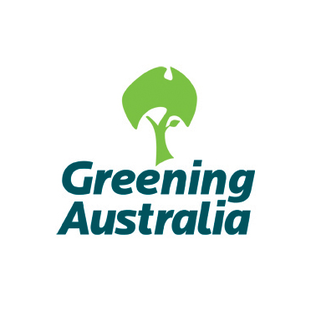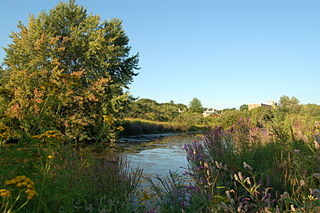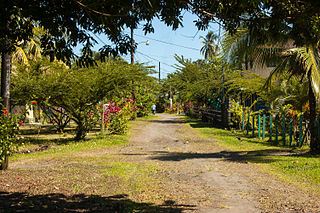
Greening Australia is an Australian environmental organisation, founded in 1982, the International Year of the Tree, to protect, restore and conserve Australia's native vegetation. Greening Australia was formed by the United Nations Association of Australia and the Nursery Industry Association of Australia.

Alewife Brook Reservation is a Massachusetts state park and urban wild located in Cambridge, Arlington, and Somerville. The park is managed by the state Department of Conservation and Recreation and was established in 1900. It is named for Alewife Brook, which was also historically known as Menotomy River, a tributary of the Mystic River.

Ngamba Island Chimpanzee Sanctuary, is an island sanctuary in Uganda, dedicated to the care of orphaned eastern chimpanzees, that have been rescued by the Uganda Wildlife Authority. Many of the chimpanzees were rescued from poachers and are unlikely to survive reintroduction to the wild.

Conservation development, also known as conservation design, is a controlled-growth land use development that adopts the principle for allowing limited sustainable development while protecting the area's natural environmental features in perpetuity, including preserving open space landscape and vista, protecting farmland or natural habitats for wildlife, and maintaining the character of rural communities. A conservation development is usually defined as a project that dedicates a minimum of 50 percent of the total development parcel as open space. The management and ownership of the land are often formed by the partnership between private land owners, land-use conservation organizations and local government. It is a growing trend in many parts of the country, particularly in the Western United States. In the Eastern United States, conservation design has been promoted by some state and local governments as a technique to help preserve water quality.
Ecotrust is a nonprofit organization based in Portland, Oregon, working to create social, economic, and environmental benefit.
Saline Wetlands Conservation Partnership (SWCP) is a conservation program devoted to the protection and preservation of Nebraska’s Eastern Saline Wetlands. Limited to the floodplain swales and depressions within the Salt Creek, Little Salt Creek, and Rock Creek drainages, it is estimated that the Eastern Saline Wetlands once covered an area in excess of 200,000 acres (810 km2). Recently, due to extensive degradation, draining and filling through commercial, residential, and agricultural development, less than 4,000 acres (16 km2) remain, and many of these remnants are highly degraded. It is becoming increasingly important to preserve this unique wetland resource. Although several existing programs have been recognized to address saline wetland conservation needs, they alone have not been enough to ensure the long term protection of this endangered resource. The Saline Wetland Conservation Partnership (SWCP) was created to offer additional protection and management of the state’s diminishing saline wetlands.
River Fields, incorporated in 1959 as a not-for-profit land trust in Louisville, Kentucky, has become the largest and oldest river conservancy advocacy group along the Ohio River to effectively protect, preserve and enhance the river front's natural and cultural resources. River Fields is the ninth oldest conservation organization in the United States. River Fields currently owns land or holds conservation easements on 33 properties, totaling more than 2,200 acres. River Fields is one of the nation's few land trusts tackling regional advocacy work as well as land conservation.
The African Wildlife Foundation (AWF) is the leading international conservation organization focused exclusively on Africa's wildlife and wild lands.

The Budongo Forest in Uganda is northwest of the capital city Kampala on the way to Murchison Falls National Park and is located on the escarpment northeast of Lake Albert. It covers parts of Hoima and Kikuube. It is known for its former abundance of East African mahogany trees as well as being home to a population of chimpanzees. An exceptionally large mahogany tree is still found here and is more than 80 meters tall and some 20 meters in circumference. The forest covers 82,530 hectares and is a catchment for Lake Albert. It is managed by National Forestry Authority (NFA).
The Bugoma Forest is a protected tropical forest that is situated southwest of Hoima and northeast of Kyenjojo towns, and east of Lake Albert, in the Hoima district of western Uganda. It was gazetted in the 1932 and came under the mandate of the National Forestry Authority in 2003. But it was expanded in 1965, 1968 and 1998. Its surface area is given as between 41,144 hectares (411.44 km2) and 65,000 hectares (650 km2).

The Victoria Basin forest–grassland mosaic is an ecoregion that lies mostly in Uganda and extends into neighboring countries. The ecoregion is centered north and west of Lake Victoria, with an outlier on the border of Ethiopia and South Sudan.
Wambabya Central Forest Reserve is located in both Hoima District and Kikuube district in Western Uganda near the north-eastern border of Bugoma Central Forest Reserve. It was demarcated in 1932. It is operated by the National Forest Authority (NFA). It covers an area of 3,429 ha (13.24 sq mi).
Mafuga Central Forest Reserve is a protected area nestled within the landscapes of Rubanda district and Rukungiri district in Western Uganda. This forest reserve, managed by the National Forestry Authority (NFA), is renowned for its biodiversity, stunning mountain scenery, and ecological features. As a key component of Uganda's Central Forest Reserves system, Mafuga Central Forest Reserve plays a crucial role in conservation efforts and serves as a haven for numerous plant and animal species.
Rwengeye Central Forest Reserve is a protected tropical high forest in Kiryanga and Pacwa subcounties that are located in Kibaale District in Western Uganda. It covers an area of 329 hecatres (3.24 km²). It is operated by the National Forestry Authority (NFA). Its WDPA ID is 39999. It was declared a forest reserve in 1932.
Nyabyeya Central Forest Reserve is a forest reserve located in Masindi District, Western Uganda, Bujenje County, Budongo sub-county, and Nyabyeya parish in western Uganda. It is part of the extensive network of Central Forest Reserves managed by the National Forestry Authority (NFA) in Uganda. This forest reserve covers an area of about 358.06 hectares. Nyabyeya Forest Reserve was created to train students in forestry under the Nyabyeya Forestry College.
Kasyoha-Kitomi Central Forest Reserve is located in Western Uganda, and has an area of 433-square-kilometre (107,000-acre). It is located south of Lake George and the Kazinga channel in the Albertine Rift eco-region, which is known for its abundance of endemic species. The forest reserve lies within the counties of Bunyaruguru, Igara and Buhweju in the administrative districts of Bushenyi, Ibanda and Kamwenge It was officially gazetted in 1932 and is controlled by Uganda's National Forestry Authority (NFA).
Kasato Central Forest Reserve is a protected tropical forest that is located in Kiryanga subcounty in Kagadi District in Western Uganda. It covers an area of 26.82 km2(2691 hectares) It managed by the National Forestry Authority. It was designated a reserve in 1965. Its WPDA ID is 39988.
Wetlands in Uganda are highly treasured natural resources that cover 30,105 square kilometres (11,624 sq mi) of Uganda's total land area of 241,500 square kilometres (93,200 sq mi) accounting to 13% of the total land area. In Uganda wetlands are locally utilized surrounding communities for construction, agriculture, tourism, crafts, furniture, fiching, human settlement and extraction of useful materials, wild fruits and hunting grounds.






